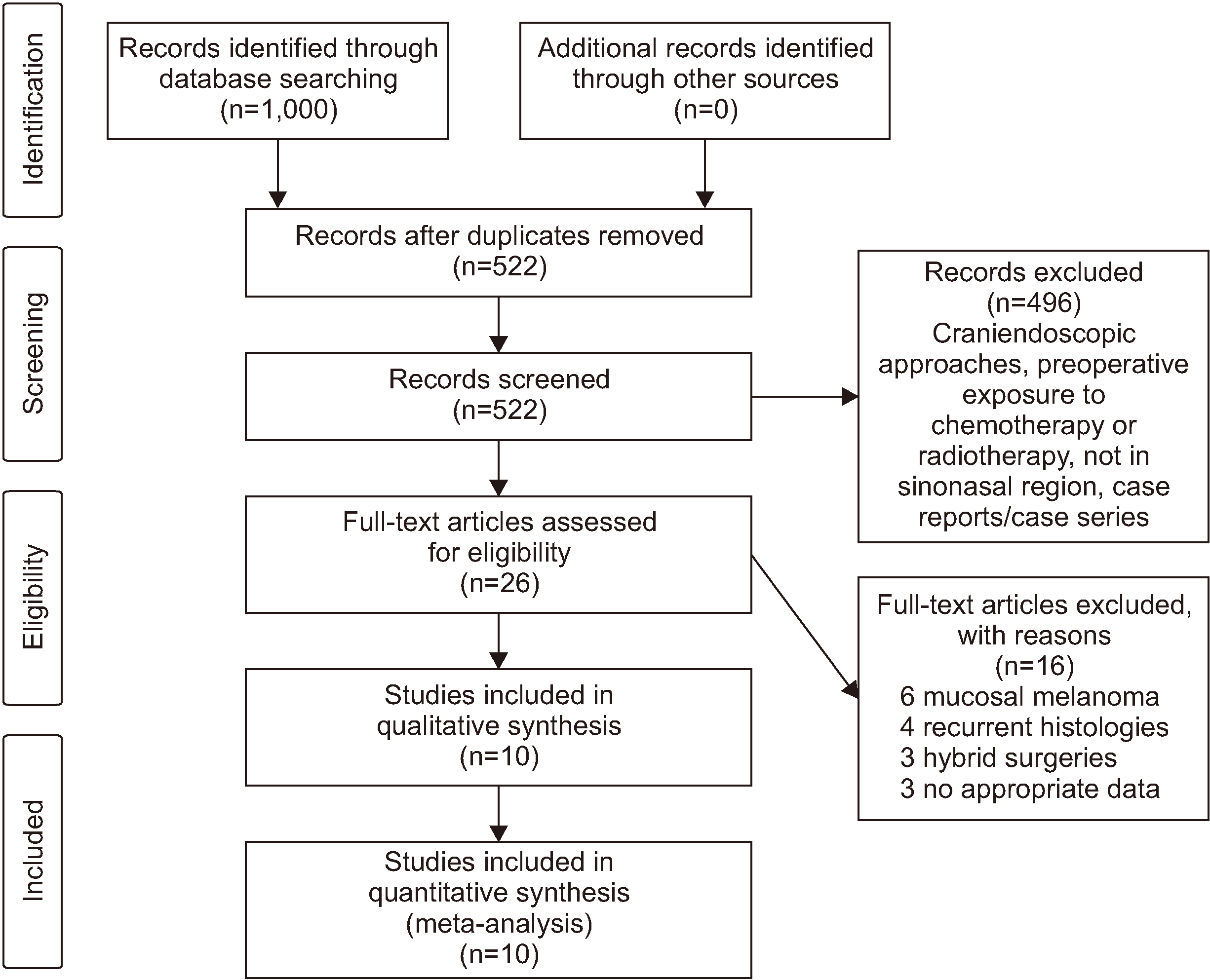I. Introduction
II. Materials and Methods
1. Search strategy
2. Selection criteria
III. Results
1. Literature search
2. Demographics and clinical features
Table 1
| Study |
Study type |
Malignancy |
Total size (n) |
Endoscopic resection (n) | Open resection (n) |
Mean age (yr) |
Sex (M/F) (%) |
Mean follow-up (mo) |
|---|---|---|---|---|---|---|---|---|
| Kilic et al.4 | RCT | SCC | 1,483 | 353 | 1,130 | 35 | 65/35 | 60 |
| Naunheim et al.12 | RCT | SCC | 55 | 10 | 45 | 58 | 69/31 | 27.4 |
| Arnold et al.14 | RCT | SCC | 900 | 399 | 501 | 63 | 67/33 | 36.3 |
| Farquhar et al.15 | RCT | SCC | 124 | 82 | 42 | 54 | 53/47 | 40 |
| Hagemann et al.16 | RCT | SCC | 225 | 123 | 102 | 63 | 60/40 | 45.4 |
| Mortuaire et al.17 | RCT | Adenocarcinoma | 43 | 20 | 23 | 70 | 98/2 | 79.2 |
| Fu et al.18 | RCT | SCC | 87 | 15 | 72 | 57 | 57/43 | - |
| Saedi et al.19 | RCT | SCC | 83 | 28 | 55 | 46 | 70/30 | 21 |
| Huang et al.20 | RCT | SCC | 47 | 27 | 20 | 58 | 60/40 | 73.6 |
| Povolotskiy et al.26 | RCT | Non SCC | 1,595 | 673 | 922 | 59 | 54/46 | 60 |
3. Positive margins
Table 2
| Outcome variables | Endoscopic resection | Open resection | P-value |
|---|---|---|---|
| Positive margins (%) | |||
| Arnold et al.14 | 68 | 62 | 0.636 |
| Farquhar et al.15 | 33 | 32 | 0.708 |
| Hagemann et al.16 | 22 | 24 | 0.080 |
| Length of hospital stay (day) | |||
| Farquhar et al.15 | 3 | 6 | 0.0001* |
| Hagemann et al.16 | 6 | 9 | 0.001* |
| Mortuaire et al.17 | 5 | 8 | 0.001* |
| Fu et al.18 | 6 | 12 | 0.01* |
| Complication rate (n) | |||
| Naunheim et al.12 | 1 | 17 | 0.75 |
| Arnold et al.14 | 0 | 5 | 0.396 |
| Hagemann et al.16 | 1 | 8 | 0.54 |
| Mortuaire et al.17 | 0 | 2 | 0.80 |
| Fu et al.18 | 2 | 1 | 0.20 |
| Recurrence rate (n) | |||
| Farquhar et al.15 | 16 | 13 | 0.058 |
| Hagemann et al.16 | 57 | 52 | 0.490 |
| Fu et al.18 | 14 | 7 | 0.21 |
| Saedi et al.19 | 59 | 58 | 0.168 |
| Huang et al.20 | 66 | 66 | 0.359 |
| Overall survival rate (%) | |||
| Naunheim et al.12 | 5 yr: 41 | 5 yr: 41 | 0.14 |
| Farquhar et al.15 | 3 yr: 91 | 3 yr: 76 | 0.135 |
| Hagemann et al.16 | 5 yr: 76 | 5 yr: 59 | 0.001* |
| Saedi et al.19 | 2 yr: 34 | 2 yr: 44 | 0.13 |




 PDF
PDF Citation
Citation Print
Print




 XML Download
XML Download